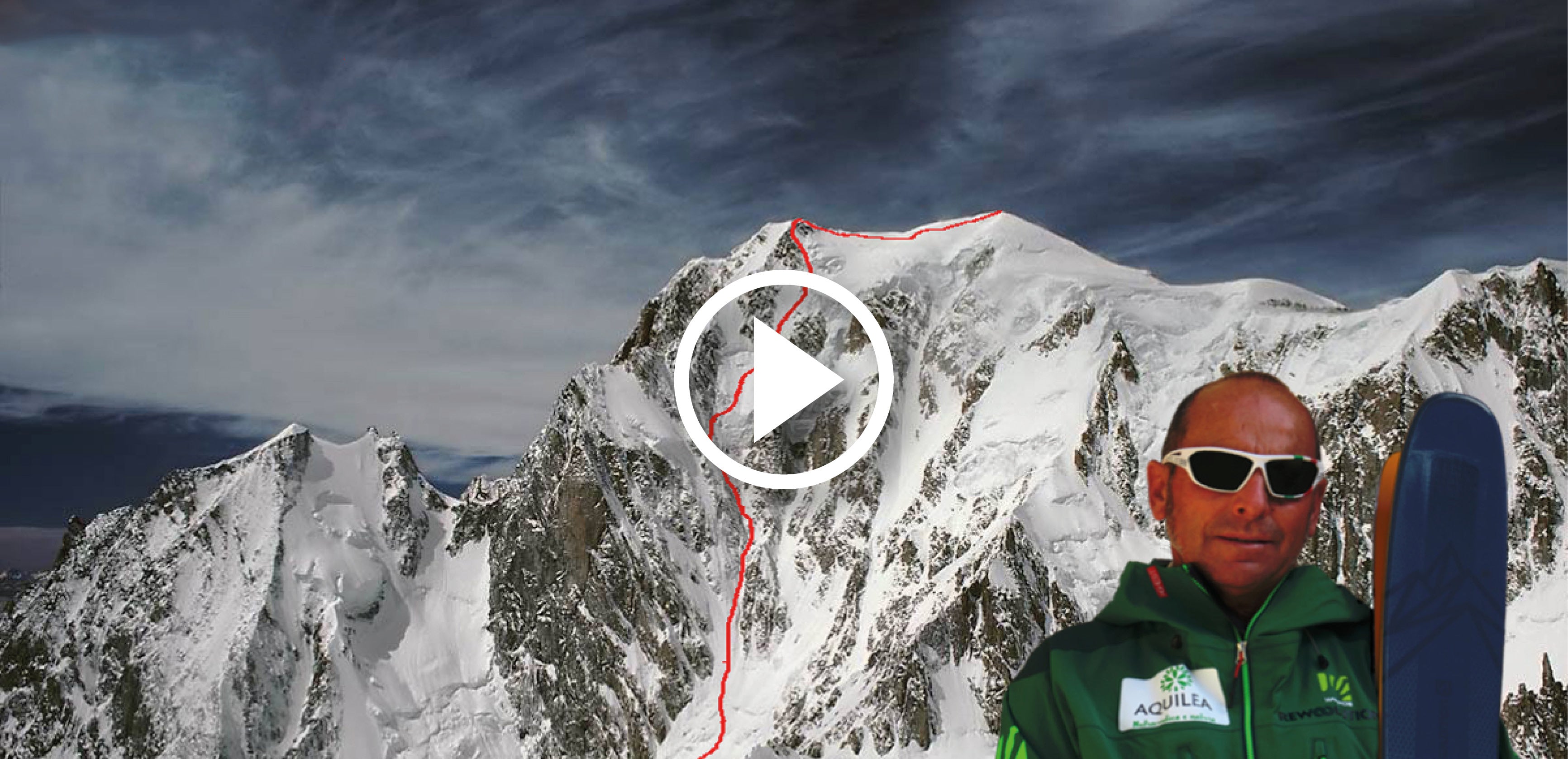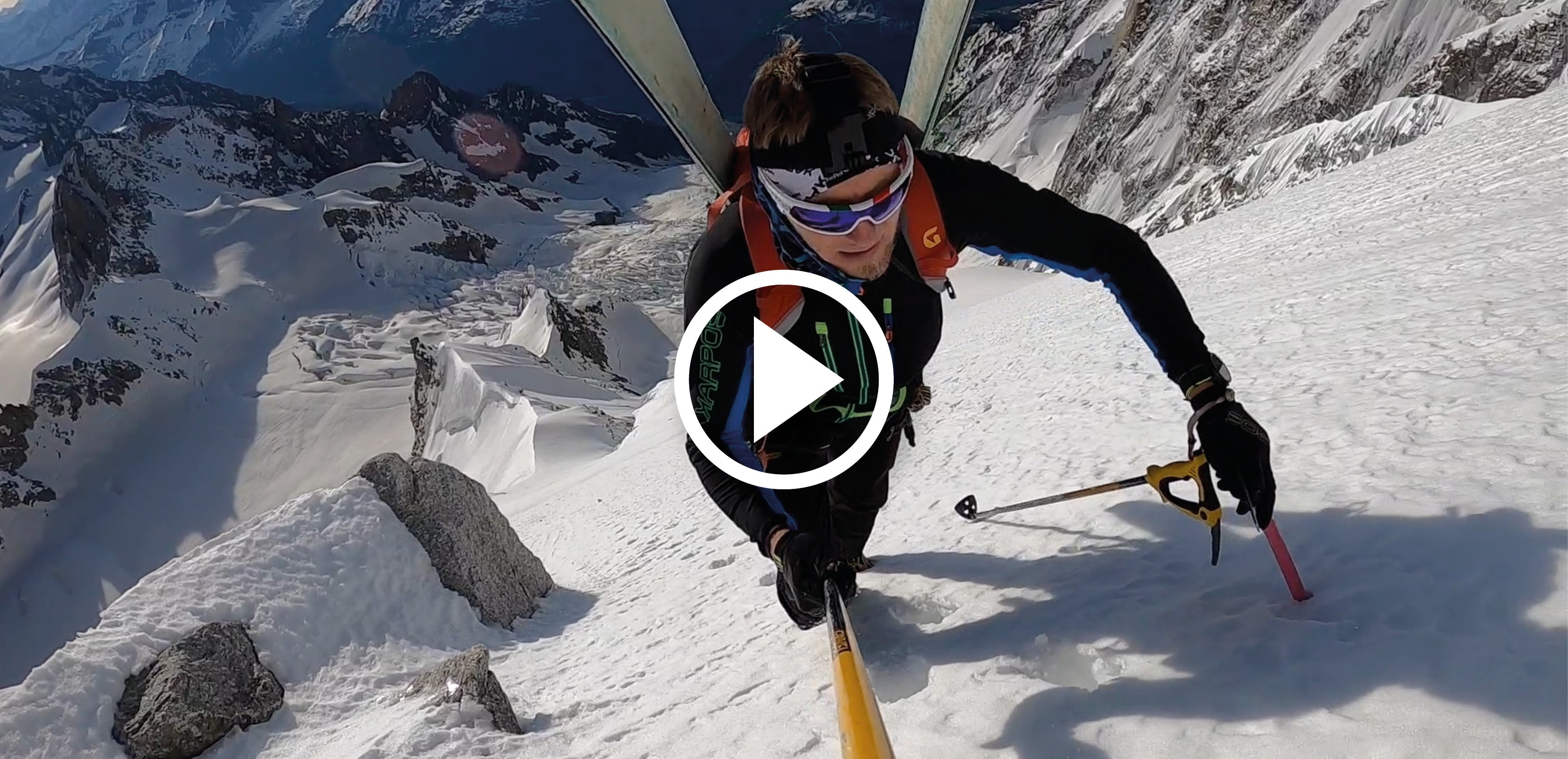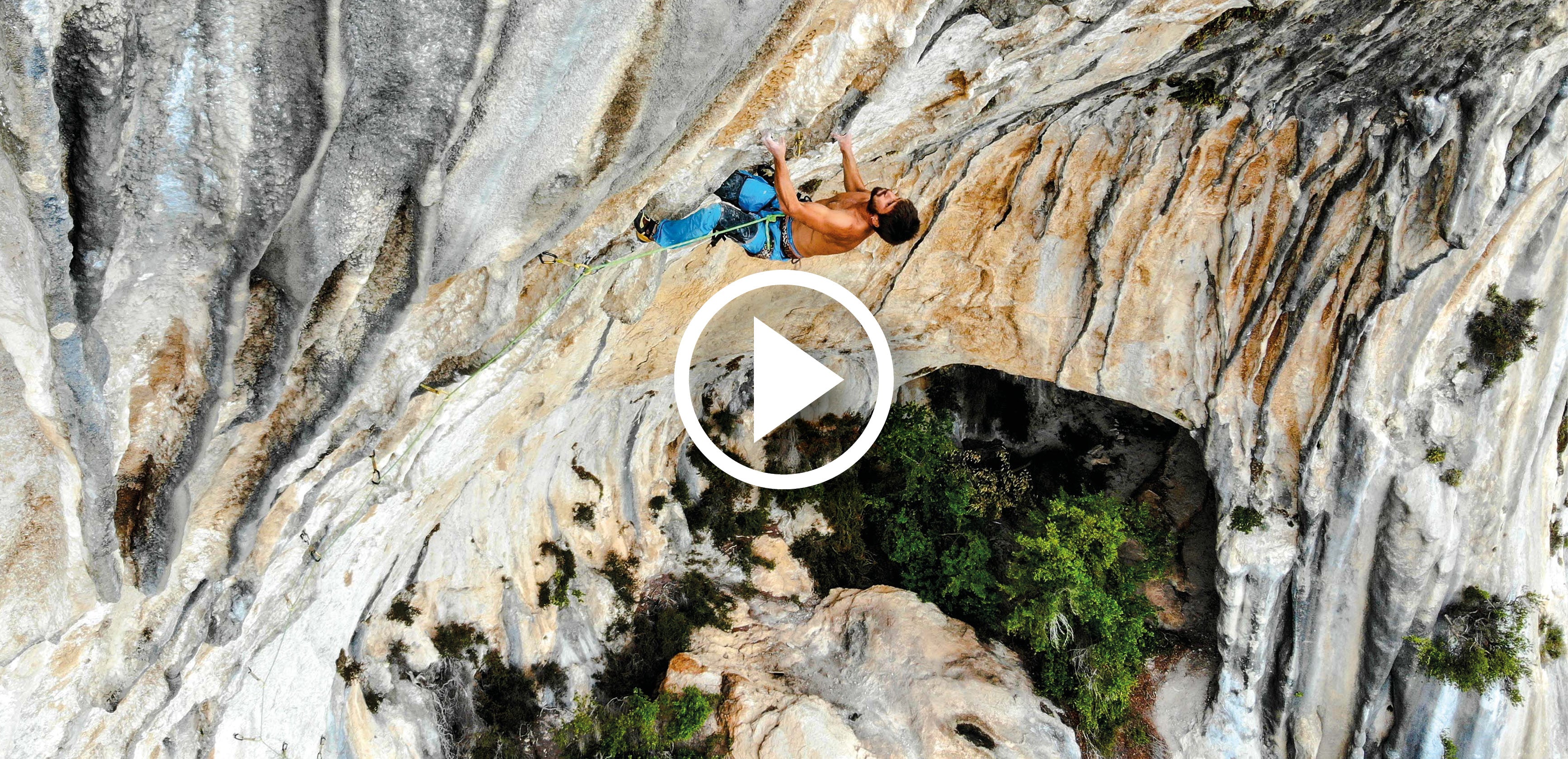
LA POIRE - FIRST DESCENT BY EDMOND JOYEUSAZ
Published on 05/06/2020
It wasn't meant to be this year, then Covid forced me to change my plans. I should have finished my descent project in the Valais, (Swiss4000SteepSki) but, the uncertainty about traveling across the border and the possibility of remaining under "house arrest" again when I returned to Italy, convinced me to anticipate the plan to ski "La Poire".
It is a rocky outcrop located just below the top of Mont Blanc, seen from below it has the unmistakable shape of a pear: The Brenva side of Mont Blanc is the wildest, most rugged and in size it has nothing to envy to the more noble walls of the Himalayan mountains. On this wall, some of the strongest climbers of all time have ventured, who have opened routes that are now part of the history of mountaineering.
The Brenva side of Mont Blanc is the wildest, most rugged and in size it has nothing to envy to the more noble walls of the Himalayan mountains. On this wall, some of the strongest climbers of all time have ventured, who have opened routes that are now part of the history of mountaineering.
The idea of skiing from the top of Mont Blanc going down the route opened in 1979 by Gianni Comino and Giancarlo Grassi came to me by observing the mountain from the balcony of the house. After years of observation and evaluation, I have identified a possible itinerary that from the top of the Mont Blanc of Courmayeur descends almost vertically between the Poire and the very steep rock spurs of the nearby Aiguille Blanche down to the Brenva glacier for 1,500 meters of altitude difference.
This is an unprecedented descent due to technical difficulties, exposure to objective dangers and total altitude difference.
The descent
Monday 25th May 2020, on the summit of Mont Blanc, the temperature was quite cold, around minus 15° with gusts of wind from the west up to 30 km/h.
The snow was not hard, but windy as often happens at those altitudes. Descending towards Mont Blanc of Courmayeur (4,748m) the slopes are gentle, so, I got to get familiar with the steep. I had skied a few days before, in the last training session, but never on steep slopes. Even for myself, the Covid 19 has created many problems, to maintain a minimum of decent training. Continuing, from the top of Mont Blanc of Courmayeur, the slopes immediately become serious, leaving the first serac on the left, a steep couloir, fortunately covered with snow, allows access to the left serac of the Poire.
When you look at this part of Mont Blanc from the bottom of the valley, you have the feeling that the environment up there is majestic, but being there is truly impressive. 
The ice of the serac has a thickness of at least 300 meters and you realize that among that ice you are an insignificant being, a 10-storey building of ice could collapse at any moment and sweep you away. But even if a small piece of ice as big as a tennis ball hits you, it could make you fall. In the days preceding the descent, I had been in flight to scout the seracs and couloirs; the conditions seemed good, even if I was not able to get very close, there was a lot of wind at more than 4000 meters, I struggled to maintain the altitude, but then, the strong north-west wind that had blown on Sunday 24 afternoon, made the conditions of the mountain worsen considerably. The snow had been swept away. The result: in many places the ice had surfaced, which made the descent considerably more difficult and dangerous.
After the first serac, there is no possibility of escape, you must necessarily go down or go back uphill, there is no possibility to exit laterally from that huge funnel of ice and vertical rocks.
3 rappels (120m) were needed to overcome the part below the serac completely free of snow. For the belays, I used two Grivel 360 ice screws: one 12 cm and the other 16cm. For the third belay two rock pitons Stiletto 503-705. I used SCREAM KIT for rappels, on a 60 m rope. Subsequently, a narrow tongue of snow in which my skis were barely allowed me to ski to the base of the Pilier d'Angle for a total of 1500 meters in descent. The descent that I made is certainly the most difficult I have faced in my career; very articulated, with constant slopes, often above 55 ° with some sections at 60 °.
GRIVEL technical gear used during the descent:
- The helmet was the DUETTO
- The harness was the MISTRAL
- I used SCREAM KIT for rappels on 60 m rope.
- The ski poles were the reliable and tested CONDOR 3, which for years have accompanied me on my most difficult descents.
- For the belays I used two Grivel 360 ice screws: one 12 cm screw and the other 16cm screw. For the third belay, two rock pitons Stiletto 503-705.
- The backpack model ZEN 35.
On this side of Mont Blanc, since the early 70s, all the strongest extreme skiers have ventured:
- In June 1973, the South Tyrolean Heni Holzer descends the Brenva spur.
- In 1977, Patrick Vallençant and Anseme Baud descend from the Peuterey ridge.
- In April 1978, Toni Valeruz is deposited on the top of Mont Blanc by a helicopter and descended on skis from the central Gran Couloir of Brenva which descended straight from the cap of Mont Blanc, between the crest of the Via Major and the Red sentinel route.
- In 1979 Gianni Comino and Stefano de Benedetti descend from the Major spur.
- In 1988 Pierre Tardivel made the first ski descent of the Pilier d'Angle after being deposited on the top by a helicopter.
I am particularly satisfied and proud to have left a "trace" on this magnificent side of Mont Blanc too.
I thank the team that has accompanied me on these adventures for years:
My friend and mountain guide Arturo Jacquemod for technical assistance.
Jean-Marie Rossi for pictures and videos.
Simone Vigna for the images with the drone.
The most important climbs:
LA BRENVA – A BRIEF HISTORY
The name of Brenva is linked to that of an Englishman Thomas Graham Brown, the last great character of English mountaineering who acts in the Alps before the second world war.
In a few years, he solved all the problems of the great wall in an extraordinarily elegant way: in 1927 he climbed the Red sentinel, in August 1928 the Major and in 1933 the Poire.
On August 5th 1933, Thomas Graham Brown completed his fantastic triptych, and with Alexander Graven and Alfred Aufdenblatten he crossed the spur placed further to the left, in the wildest sector of the whole wall, where a curious pear-shaped rocky tower ("the Poire ”) is wedged between two gigantic cascades of seracs. The Pear is the only access door to the upper part of the wall, indeed a small petiole of rock allows it to be grafted to the upper ice slopes.
This is certainly the most difficult and risky route on the Brenva side, as to reach the base you need to cross all the gullies that serve as an avalanche discharge. But, it is also the one that offers the wildest environment, a climb that leaves indelible emotions and memories.
- 1865 - July 15th. The Swiss guides Jakob and Melchior Anderegg accompany a group of English mountaineers, including Adolphus Warburton Moore, the creator of the project, climb to Mont Blanc for the “Sperone della Brenva” (Brenva Spur), overcoming without crampons, stepping, slopes close to 60 °. Moore was the creator and animator of the company, in fact today the hill leading to the spur bears his name. The ascent of the Brenva spur is one of the most classic and elegant itineraries of the entire Alpine chain.
- Unfortunately, on 17th August 1956 Arturo Ottoz, the most prominent guide of Courmayeur at that time was overwhelmed by an avalanche at the foot of via Major. He had already climbed this route in 1953 with Toni Gobbi.
- 1957 – 1st-3rd August. The Grand Pilier d’Angle came to the fore in the mountaineering world, when Walter Bonatti and Toni Gobbi climbed the East-Northeast face, a pillar more than 900 meters high.
- 1959 - March 9th. Walter Bonatti with Gigi Panei, made the first winter ascent of Mont Blanc on the route of the "Sentinella Rossa"
- 1959 September 13th. Carlo Mauri, realizes the 1st solo ascent of Poire.
- 1969 February. Alessio Ollier and Attilio Ollier with Franco Salluard, make the 1st winter ascent of the Poire.
- 1975- February. Mitsunori Shigi, realizes the 1st solo winter ascent of the Major route.
- 1976 - March. Mitsunori Shigi, makes the 1st winter solo ascent of thePoire
- 1979 – the night between 10th and 11th August. Gianni Comino and Giancarlo Grassi climb from the Serac to the left of the Poire. Difficult climb in an exceptionally severe environment, extremely dangerous for the fall of ice.
- In 1980 Gianni Comino lost his life trying to climb the serac enclosed between the spurs of the Major and Poire which barred the chimney at the top of Mont Blanc. While near the exit, Comino was hit by a rock fall and crashed.
General information
The Brenva wall, from the patois “larch”, takes its name from the glacier of the same name which once lapped the pastures of the valley floor, today its front covered with debris occupies the entire mouth of the Val Veny. The Brenva glacier is the fourth glacier in the Aosta Valley: it extends for 730 hectares and is 6700 meters long. It is located on the Italian side of the Mont Blanc massif at the level of Aiguille Blanche de Peuterey and Aiguille Noire de Peuterey. It is considered the highest icefall in the Alps: from the top of Mont Blanc it descends to Val Veny at an altitude of 1,300 m a.s.l. with a vertical drop of 3,500 m. It is an imposing slope, with Himalayan characteristics for altitude and morphology, mainly of ice, characterized by three main buttresses, partly rocky, separated from each other by very steep strains and gigantic seracs. On this extraordinary wall, up to 1,400 meters high and even wider, some of the most beautiful and prestigious routes in the Alps are traced, all serious, long and demanding. It is a dangerous wall, important collapses of seracs and rock falls are the order of the day, any itinerary you want to travel you need to leave early at night to be out of the reach of the discharges at sunrise, it must not be forgotten it is oriented to the east. The glacial cap that constitutes the summit building of Mont Blanc, overlooking the Brenva side, curls like a frowning and corrugated forehead and forms some cascades of seracs that remain fearfully suspended in the balance above the gullies of snow and ice, which serve precisely for unloading avalanches of snow generated by falling ice blocks. These ravines and deep gullies are separated by some rocky and icy spurs in relief, which constitute the only point relatively safe from the falls of seracs, and it is along these spurs that the ascent routes took place. But to reach the base of the ridges it is often necessary to cross the numerous gullies exposed to the discharges: the climbs on this side require a great nervous balance and a proven technical experience.

Edmond Joyeusaz
Born in 1958, he has always lived in Courmayeur at the foot of Mont Blanc. Mountain Guide and extreme skier, he holds several first descents in Himalaya and in the Alps.
Favorite products: Condor 3, Scream kit, Mistral harness


